Adelaide, the capital city of South Australia, is home to a diverse range of bird species, from the urban dwelling seagulls to the colorful parrots and cockatoos found in the suburban parks and gardens.
With its Mediterranean climate and abundance of natural habitats, this city offers a thriving environment for a wide array of birdlife.
From the endangered Nicobar pigeon to the native Adelaide rosella, bird enthusiasts can enjoy observing and learning about these fascinating creatures throughout the year.
With over 100 species of birds found in the Adelaide region, this city is indeed a haven for birdwatchers and nature lovers.
1. Rainbow Lorikeet
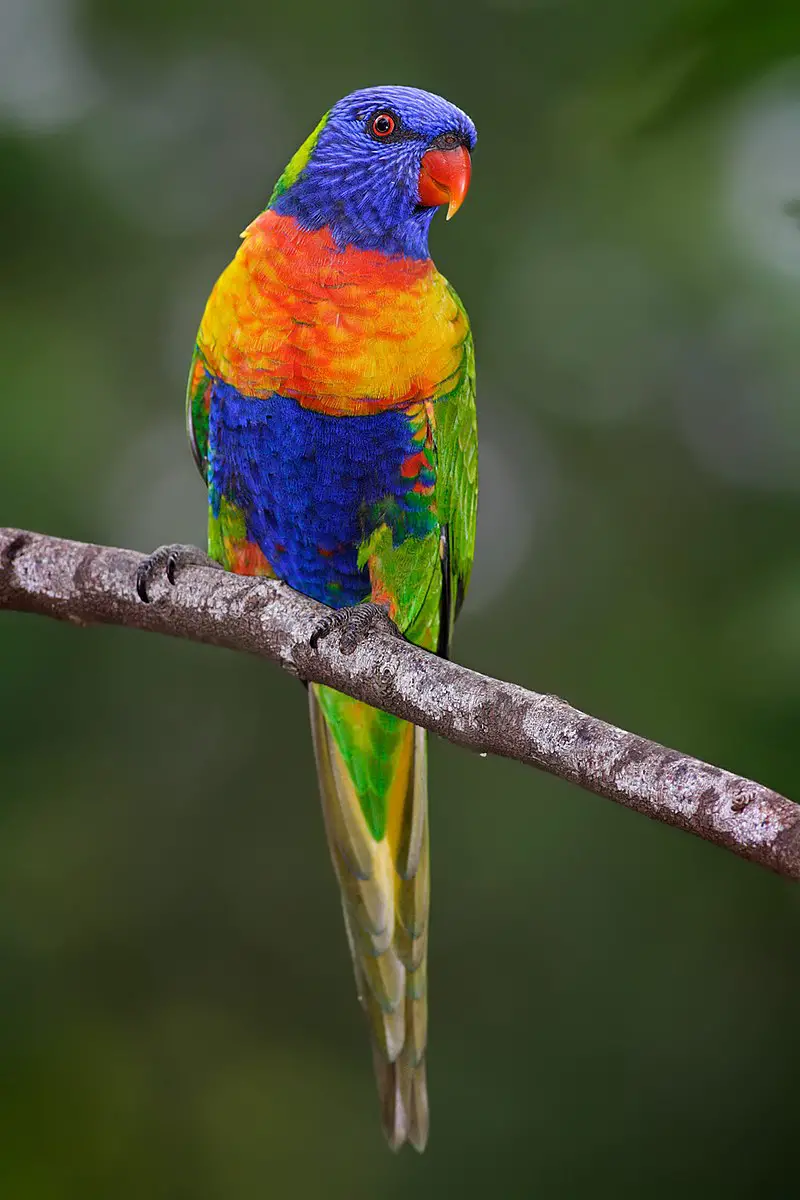
The Rainbow Lorikeet is a brightly coloured parrot native to Australia. It inhabits rainforests, coastal bushlands and woodland areas along the eastern seaboard from northern Queensland to South Australia.
These birds have an unmistakable bright rainbow plumage of blue, red and yellow feathers which make them easy to recognise in their natural environment.
They are also known for their distinctive call – often described as sounding like ‘kikiki-kyu’.
Six related species were once considered subspecies of the Rainbow Lorikeet but these days they are recognised separately due to differences in size, colouration and behaviour.
Despite being introduced elsewhere such as New Zealand, Hawaii or California they remain largely confined within their original range in Australia – where they can be seen soaring through the air or drinking nectar from flowers with its long tongue.Scientific classification:
| Kingdom | Animalia |
| Phylum | Chordata |
| Class | Aves |
| Order | Psittaciformes |
| Family | Psittaculidae |
| Genus | Trichoglossus |
| Species | T. moluccanus |
Also Featured In: Most common birds in Australia, Aviary Birds You Should Know
2. Rainbow Bee-Eater
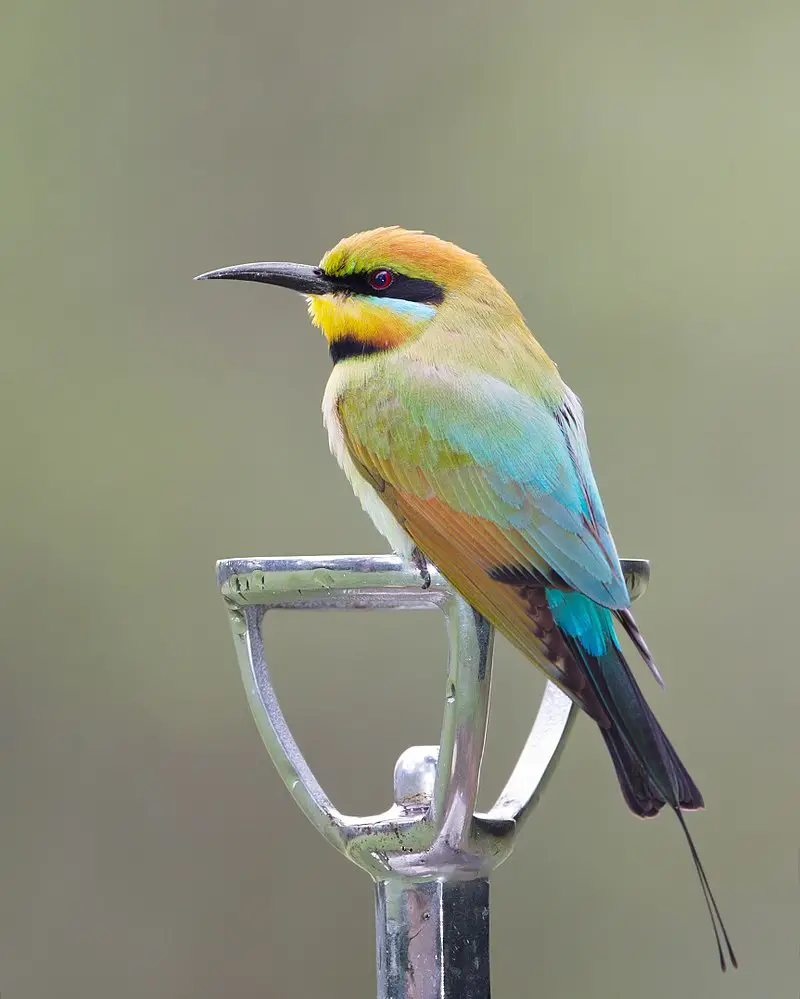
The Rainbow bee-eater (Merops ornatus) is a delightful near passerine bird belonging to the bee-eater family Meropidae.
It is found exclusively in Australia, making it one of only two species of its kind throughout the world; its closest relative being located in Southern and Eastern Africa – the olive bee-eater (Merops superciliosus).
Its stunning plumage features a unique palette of colours including shades pinkish reds, blues, greens and yellows which make for an impressive display when seen up close.
Due to their diet consisting mainly on bees and other insects they have adapted specialised beaks with serrated edges that allow them to easily capture their prey mid flight.
A truly remarkable sight indeed.Scientific classification:
| Kingdom | Animalia |
| Phylum | Chordata |
| Class | Aves |
| Order | Coraciiformes |
| Family | Meropidae |
| Genus | Merops |
| Species | M. ornatus |
Also Featured In: Birds that Found in Kakadu National Park, Queensland Birds You Should Know
3. Crested Pigeon
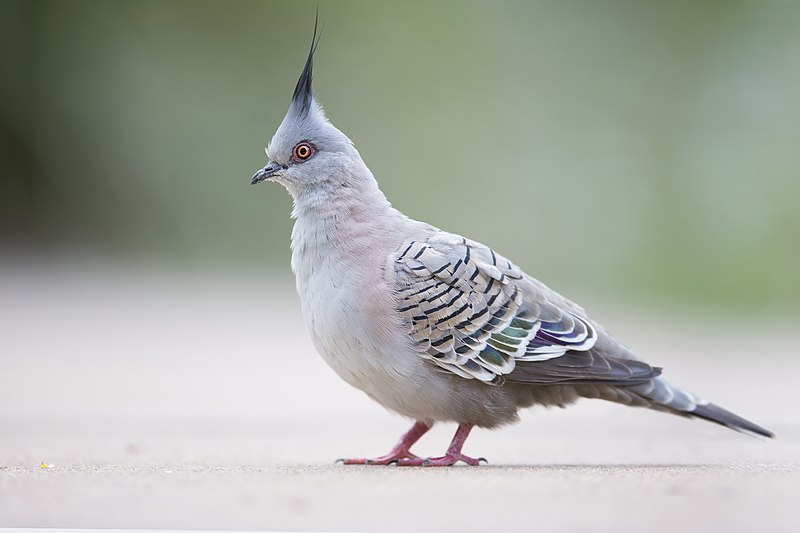
The Crested Pigeon is a medium-sized bird found widely across mainland Australia. It stands out from other pigeons due to its unique erect crest on the top of its head, which gives it an unmistakable look.
The body of this pigeon is slate grey in color with lighter gray undersides and chestnut colored wings that have white tips when they are open while flying.
Its striking black tipped yellow beak and pale blue eye ring add further interest to this beautiful species.
When alarmed, these birds will make loud clapping sounds by bringing their wings together above their backs as part of their defensive behavior.Scientific classification:
| Kingdom | Animalia |
| Phylum | Chordata |
| Class | Aves |
| Order | Columbiformes |
| Family | Columbidae |
| Genus | Ocyphaps G.R. Gray, 1842 |
| Species | O. lophotes |
Also Featured In: Most Common Birds in Oceania,
4. Australian Pelican
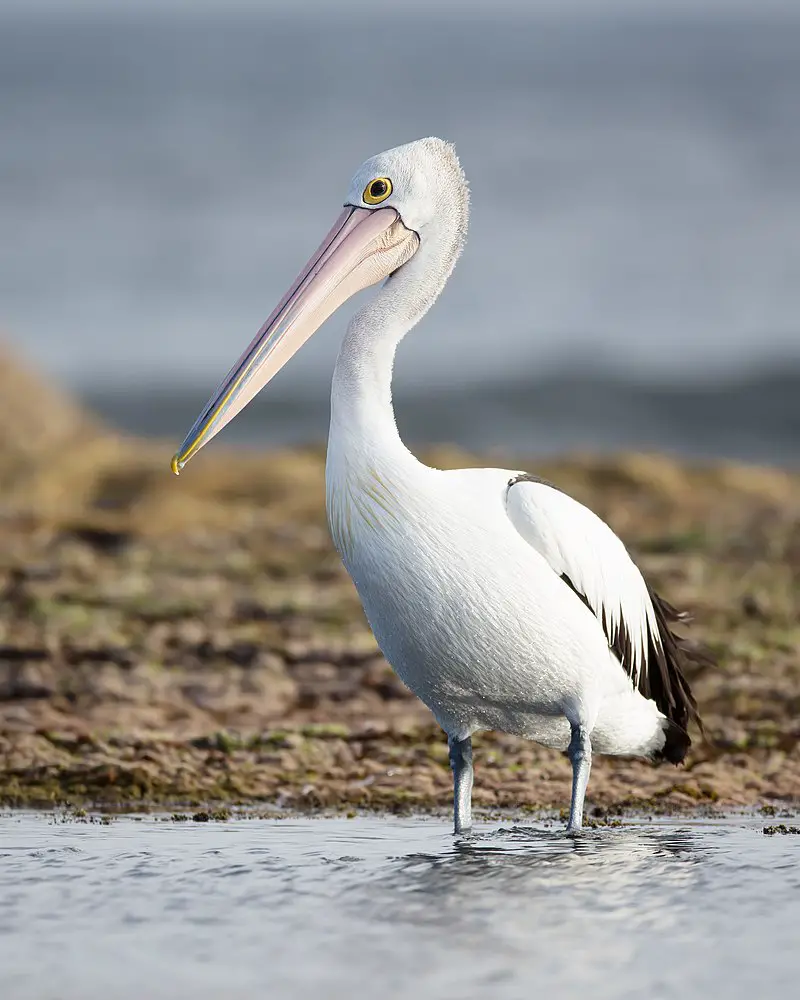
The Australian pelican is a majestic large waterbird with predominantly white plumage and black wings.
It has the longest bill of any living bird, which it uses to fish for its main source of food in both inland and coastal waters of Australia, New Guinea, Fiji, parts of Indonesia and as a vagrant in New Zealand.
They usually feed together by forming lines or circles around their prey before dipping down into the water at once.
In addition to fishing they also scavenge on other sources such as eggs from nesting seabirds or carrion.
Their unique appearance makes them an iconic species that can be easily recognised across many areas throughout Australasia making them popular amongst tourists who come to see them up close.Scientific classification:
| Kingdom | Animalia |
| Phylum | Chordata |
| Class | Aves |
| Order | Pelecaniformes |
| Family | Pelecanidae |
| Genus | Pelecanus |
| Species | P. conspicillatus |
Also Featured In: Birds of Tasmania,
5. Noisy Miner
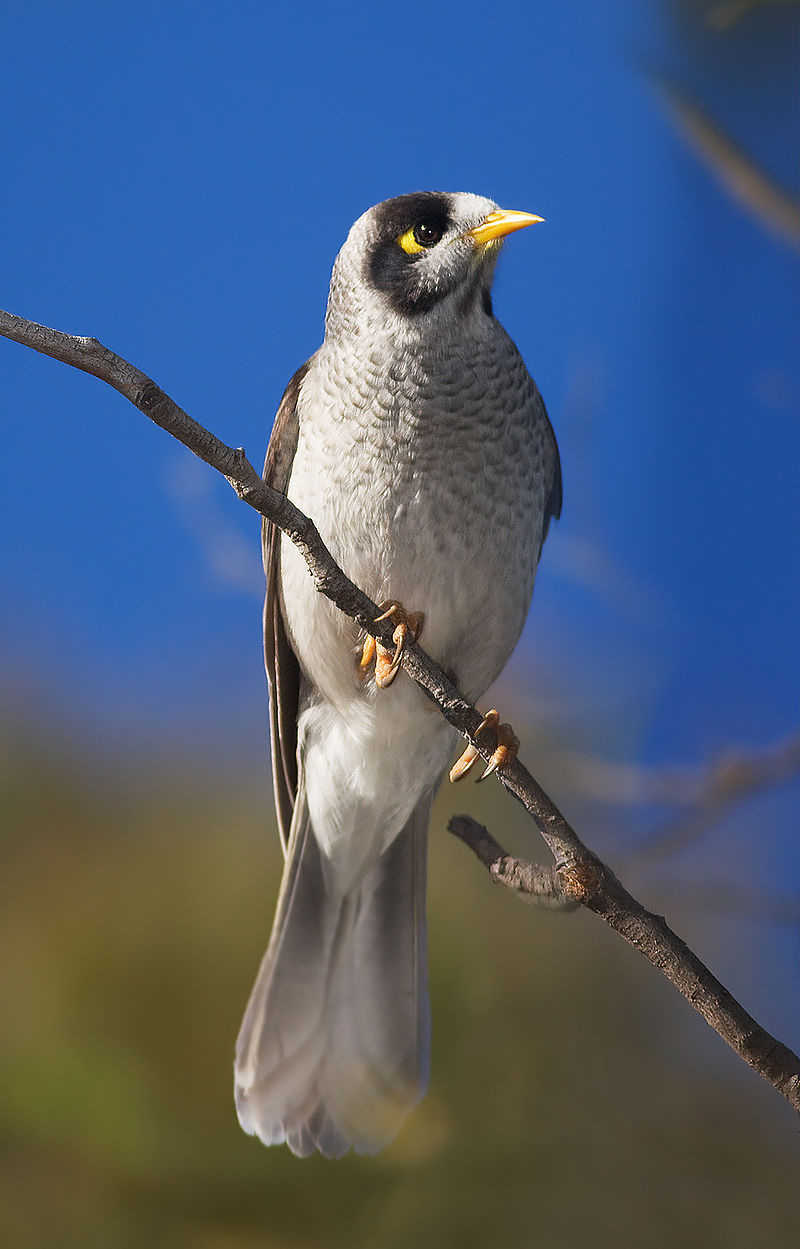
The Noisy Miner is a beautiful bird native to eastern and southeastern Australia. It has a grey body, black head, orange-yellow beak and feet, with an eye patch that ranges from yellow to more intense in Tasmanian birds.
The tail feathers are distinguished by white tips which provide it with its signature look. These miners have the ability to produce loud calls when communicating or defending their territory – hence their name.
They mainly feed on fruit but also insects, nectar and small lizards found around gardens.
As they are quite common in urban areas of Australia, these birds make for some delightful avian visitors.Scientific classification:
| Kingdom | Animalia |
| Phylum | Chordata |
| Class | Aves |
| Order | Passeriformes |
| Family | Meliphagidae |
| Genus | Manorina |
| Species | M. melanocephala |
6. New Holland Honeyeater
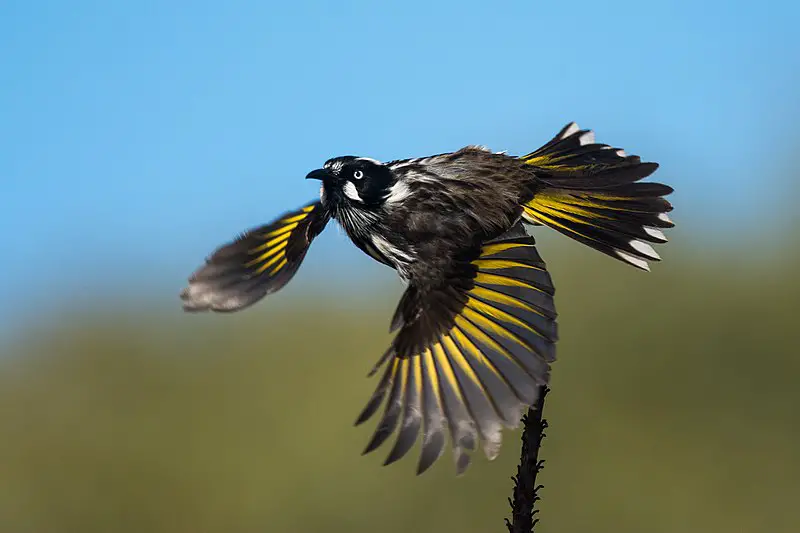
The New Holland honeyeater is a distinctive bird found in southern Australia. It has five subspecies and measures 18 cm long, with mainly black feathers contrasting against its white eyes.
This species was among the first to be scientifically described in Australia, known as Certhia novaehollandiae at that time.
These birds are very active and can often be seen searching for food or bathing on hot days near water sources such as streams or lakes.
They have an impressive range of vocalizations which they use to communicate with each other when looking for mates or defending their territories from intruders.
The New Holland Honeyeaters feed primarily on nectar but also consume insects, lizards, spiders and seeds when available throughout the year – making them essential pollinators within Australian ecosystems.Scientific classification:
| Kingdom | Animalia |
| Phylum | Chordata |
| Class | Aves |
| Order | Passeriformes |
| Family | Meliphagidae |
| Genus | Phylidonyris |
| Species | P. novaehollandiae |
Also Featured In: Most Common Western Australia Birds, Small Birds that Live in New South Wales
7. Masked Lapwing
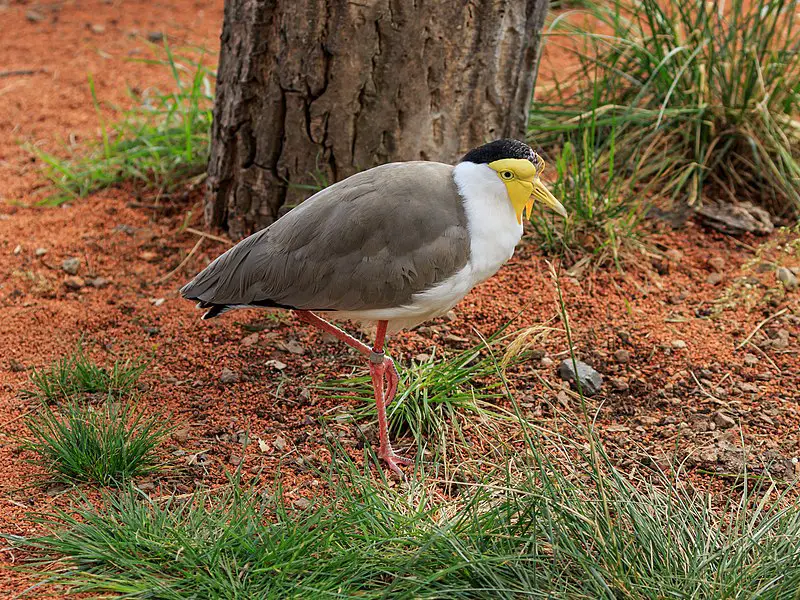
The Masked Lapwing is a large, distinctive bird that can be found in Australia, New Zealand and parts of Papua New Guinea.
It spends most of its time on the ground searching for food such as insects and worms, making it an important part of the local ecology.
It has several loud calls that are easily recognisable – from its ‘kwee-ep’ alarm call to its territorial ‘chi-wick’ call.
The Masked Lapwing is particularly known for swooping down when disturbed or threatened; however this behaviour serves to protect their nests with chicks during breeding season.
They inhabit open fields and grasslands which makes them easy to see if you’re lucky enough.Scientific classification:
| Kingdom | Animalia |
| Phylum | Chordata |
| Class | Aves |
| Order | Charadriiformes |
| Family | Charadriidae |
| Genus | Vanellus |
| Species | V. miles |
8. Dusky Moorhen
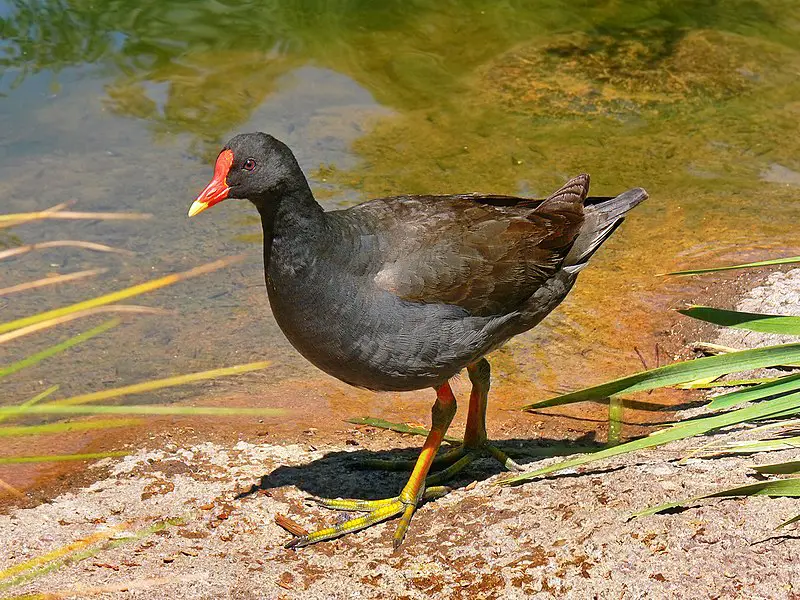
The dusky moorhen is a species of bird found in India, Australia, New Guinea, Borneo and Indonesia. It has dark plumage with an iridescent green sheen on its back and wings.
Its beak and legs are yellow-orange in color. The tail is long and pointed. Dusky moorhens live around freshwater wetlands such as swamps or ponds where they feed largely on aquatic vegetation but may also eat small insects or fish if available.
They often live alongside other birds from the same genus like purple swamphens or Eurasian coots which have similar appearances but different habitats preferences than their own species’.
Although timid when approached by humans these birds still make fascinating subjects for observation due to their unique behaviors within family groups that can help us understand more about them.Scientific classification:
| Kingdom | Animalia |
| Phylum | Chordata |
| Class | Aves |
| Order | Gruiformes |
| Family | Rallidae |
| Genus | Gallinula |
| Species | G. tenebrosa |
Also Featured In: Timor-Leste birds, Common Melbourne Birds
9. Diamond Firetail
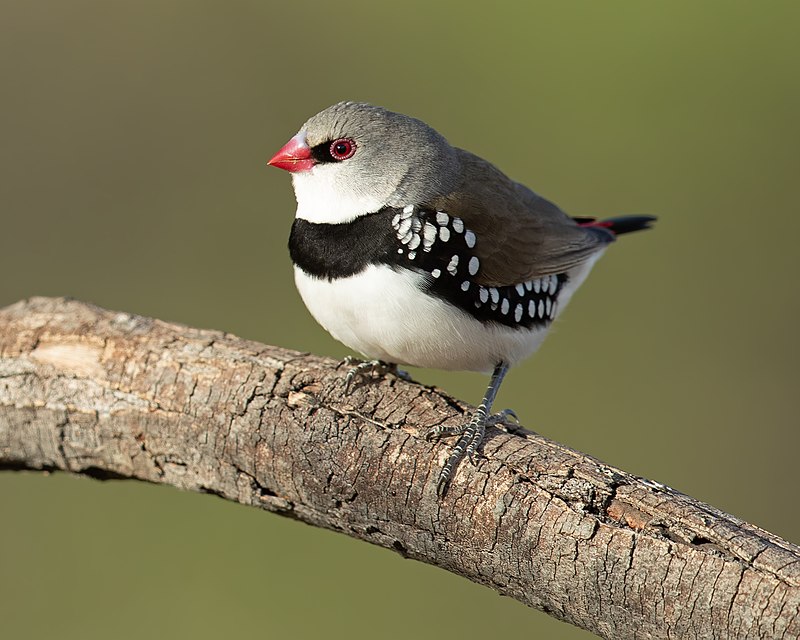
The Diamond Firetail is a species of estrildid finch that is endemic to Australia and can be found in drier forests and grassy woodlands west of the Great Dividing Range from South East Queensland to the Eyre Peninsula in South Australia.
It has bright plumage consisting mainly of black, white, chestnut brown, yellowish-brown with red patches on its wings.
The males have a distinctive bluish-grey patch around their eyes while females are more plain grey or olive green.
Despite being small it’s one of the largest finches in Australia measuring up to 13 cm long and weighing up 15 gms at maturity.
These birds feed primarily on insects but also consume seeds sometimes as well as nectar when available during spring time for breeding season.Scientific classification:
| Kingdom | Animalia |
| Phylum | Chordata |
| Class | Aves |
| Order | Passeriformes |
| Family | Estrildidae |
| Genus | Stagonopleura |
| Species | S. guttata |
Also Featured In: Finches Species, New South Wales Birds You Need to See
10. Silver Gull

The Silver Gull is a common sight in Australia, especially along the coastlines. It’s smaller than the Pacific Gull and has silver-grey wings with white head and underparts.
Its scientific name is Chroicocephalus novaehollandiae, but it shouldn’t be confused with the Herring Gull which is also called “Silver Gull” in many other languages (Larus argentatus).
During summer months these birds can often be seen around fishing boats scavenging for discarded food or flying low over city parks looking for handouts from humans.
They are highly adaptable to their environment making them quite successful at coexisting near human populations.
These Australian seabirds have been known to live up to 25 years old.Scientific classification:
| Kingdom | Animalia |
| Phylum | Chordata |
| Class | Aves |
| Order | Charadriiformes |
| Family | Laridae |
| Genus | Chroicocephalus |
| Species | C. novaehollandiae |
Also Featured In: Gulls Species, Birds that Live around Brisbane
11. White-Winged Fairywren
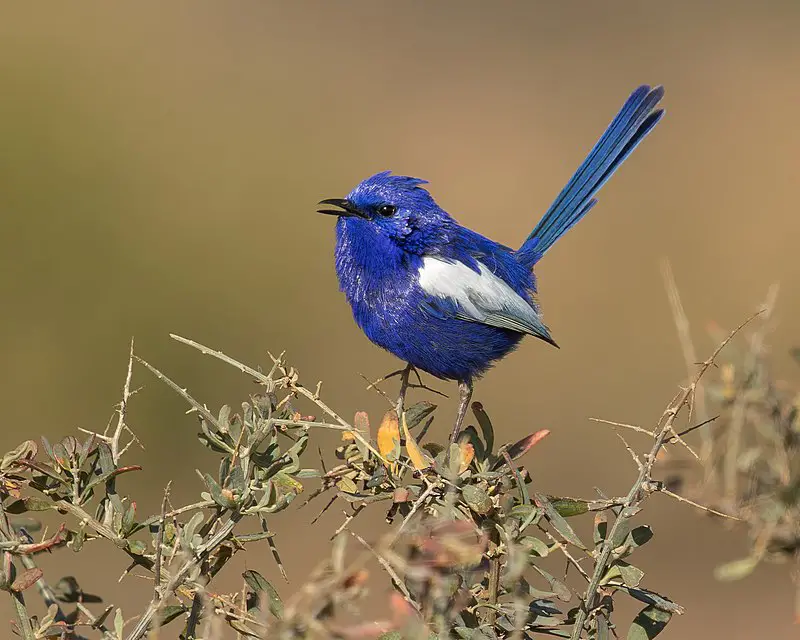
The White-winged Fairywren is a species of passerine bird from the Australasian wren family. It inhabits Central Australia, ranging from South Australia to Queensland and Western Australia, in drier regions.
Males are known for their brightly coloured plumage during breeding season while females display dull feathers year round.
This sexual dimorphism helps males attract mates more easily and provides insight into the species’ social structures: one or more males will dominate a group with bright colours as signs of dominance over other members within it.
The diet consists mainly of small insects such as ants, spiders and grasshoppers supplemented by seeds when available.
They often feed in pairs or larger groups which can help spot predators better than when alone; they also perch atop shrubs to look out for any potential dangers quickly before returning back to ground level to resume feeding once again.Scientific classification:
| Kingdom | Animalia |
| Phylum | Chordata |
| Class | Aves |
| Order | Passeriformes |
| Family | Maluridae |
| Genus | Malurus |
| Species | M. leucopterus |
Also Featured In: Wrens Species,
12. Magpie-Lark
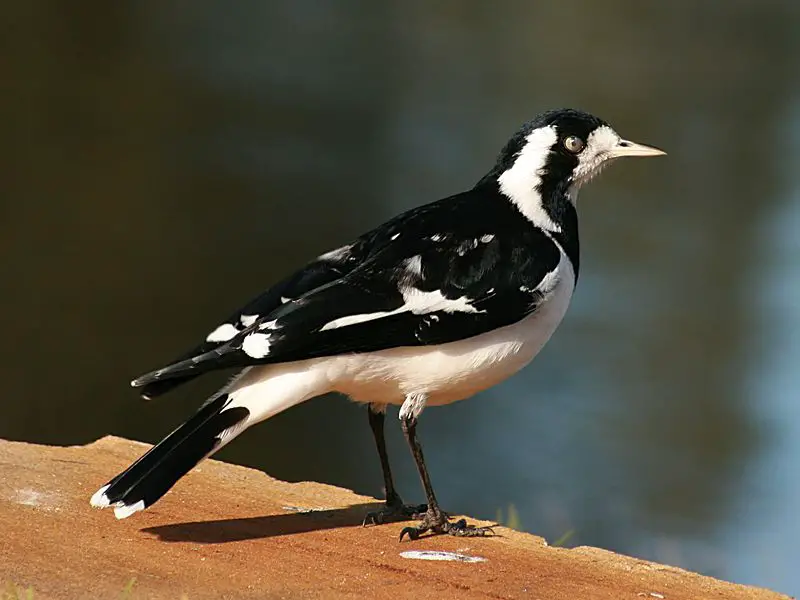
The Magpie-lark is a bird found in Australia, Timor, and southern New Guinea. It has black and white plumage, with different patterns for males and females.
John Latham first described this species in 1801. Formerly known as a mudnest builder, it has been reclassified recently.
The bird has several nicknames such as Wee magpie, Peewee, Peewit, and Mudlark.
It is a passerine bird, and its scientific name is Grallina cyanoleuca. The Magpie-lark is known for its beautiful call, which is similar to the sound “pee-wee.” It is a unique species that adds to the diversity of Australia’s wildlife.
The bird is a favourite among birdwatchers and nature lovers in general.Scientific classification:
| Kingdom | Animalia |
| Phylum | Chordata |
| Class | Aves |
| Order | Passeriformes |
| Family | Monarchidae |
| Genus | Grallina |
| Species | G. cyanoleuca |
Also Featured In: Birds that Charles Darwin Studied, Birds that Live around Victoria
13. Royal Spoonbill

The royal spoonbill is a large bird found in wetlands across Australia, New Zealand, Papua New Guinea, and the Solomon Islands. Known for its distinctive spoon-shaped bill, it feeds on small fish, crustaceans, and insects in intertidal flats and shallow waters.
This black-billed spoonbill is also sometimes sighted as a vagrant in New Caledonia. In New Zealand, it is called kōtuku ngutupapa by the Māori people.
The royal spoonbill is often seen wading through water with its head bobbing back and forth as it searches for prey.
Its striking all-white plumage and bright yellow crest make it a popular sight for birdwatchers and nature enthusiasts.
The royal spoonbill is a fascinating bird, perfectly adapted to its aquatic habitat and always a delight to see in the wild.Scientific classification:
| Kingdom | Animalia |
| Phylum | Chordata |
| Class | Aves |
| Order | Pelecaniformes |
| Family | Threskiornithidae |
| Genus | Platalea |
| Species | P. regia |
Also Featured In: Sydney Birds You Need to See, Birds of New Caledonia
14. Freckled Duck
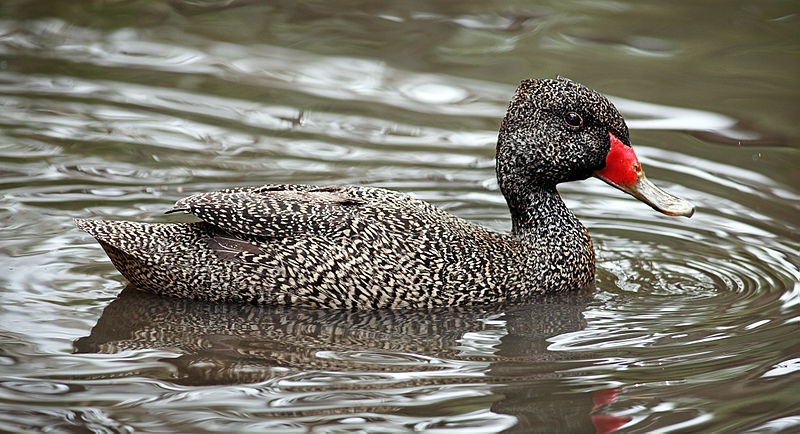
The Freckled duck is a unique waterfowl that can be found in mainland Australia. They are also known as monkey duck or oatmeal duck.
During the dry season, they disperse to coastal and subcoastal wetlands in search of water.
These birds are known for congregating in large flocks during this period. The Freckled duck has a distinctive appearance with its freckled plumage and blue-grey beak.
Its habitat is mostly in freshwater wetlands, and they feed on aquatic plants and small invertebrates.
While they are not considered endangered, their population is declining due to habitat loss and degradation.
Conservation efforts are being made to protect and preserve their natural habitats. The Freckled duck is a fascinating species that adds to the diversity of Australian wildlife.Scientific classification:
| Kingdom | Animalia |
| Phylum | Chordata |
| Class | Aves |
| Order | Anseriformes |
| Family | Anatidae |
| Subfamily | Stictonettinae Boetticher, 1950 |
| Genus | Stictonetta Reichenbach, 1853 |
| Species | S. naevosa |
Also Featured In: Birds that You’ll find in Perth,
15. Australasian Shoveler
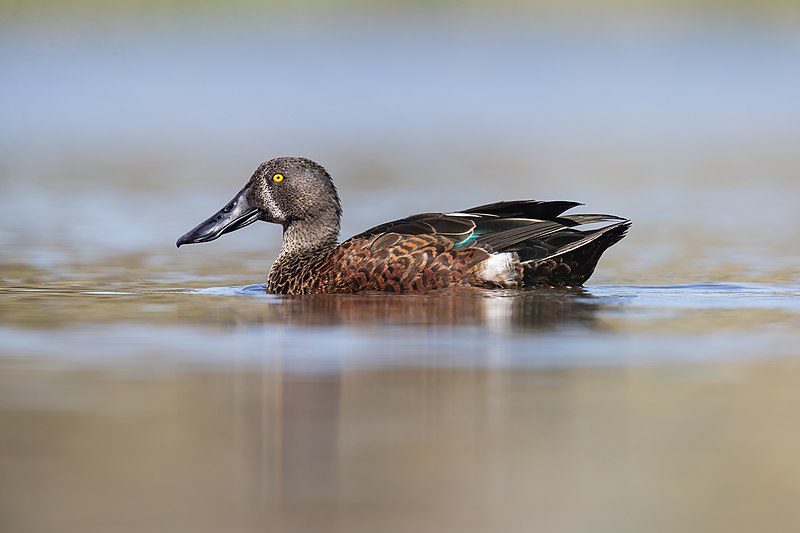
The Australasian shoveler is a species of duck found in parts of Australia, Tasmania, and New Zealand. These birds typically live in swamps with dense vegetation.
They are a protected species under the National Parks and Wildlife Act in Australia.
These ducks range in size from 46 to 53 cm and are known for their blue-grey heads with a white crescent in front of their eyes.
The male Shoveler has these distinct features. They are a dabbling duck species and are known for their unique bill shape that is used to filter food from the water.
These ducks can often be seen foraging on the surface of swamps and ponds in search of food.
The Australasian shoveler is a remarkable species and a vital part of the wetland ecosystem.Scientific classification:
| Kingdom | Animalia |
| Phylum | Chordata |
| Class | Aves |
| Order | Anseriformes |
| Family | Anatidae |
| Genus | Spatula |
| Species | S. rhynchotis |
16. Hooded Dotterel
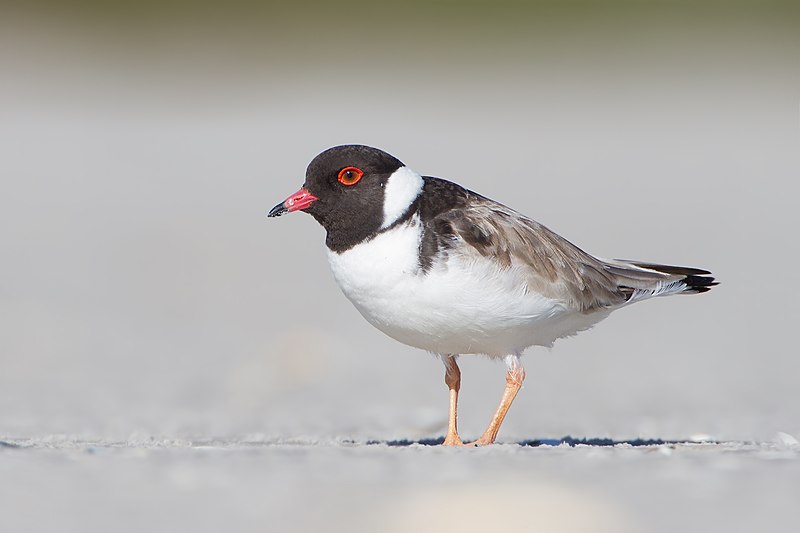
The Hooded Dotterel is a bird species that belongs to the Charadriidae family. It can be found exclusively in southern Australia, mostly inhabiting ocean beaches and subcoastal lagoons.
This bird species has two identified subspecies, with distinct populations in the east and west.
The eastern subspecies is particularly vulnerable, with different listings according to conservation organizations.
The Hooded Dotterel is also called the Hooded Plover, and it is a small bird with a distinct appearance.
Despite being a beach bird, it is not a strong swimmer and relies on its long, thin legs to move quickly on the sand.
Sadly, this bird species is threatened by human activities, such as off-road vehicles and unleashed dogs, and habitat destruction due to coastal development.
Therefore, conservation efforts are essential to protect this unique and important bird species.Scientific classification:
| Kingdom | Animalia |
| Phylum | Chordata |
| Class | Aves |
| Order | Charadriiformes |
| Family | Charadriidae |
| Genus | Thinornis |
| Species | T. cucullatus |
Also Featured In: South Australian Birds, Birds that Live in Kangaroo Island
17. Australian Wood Duck
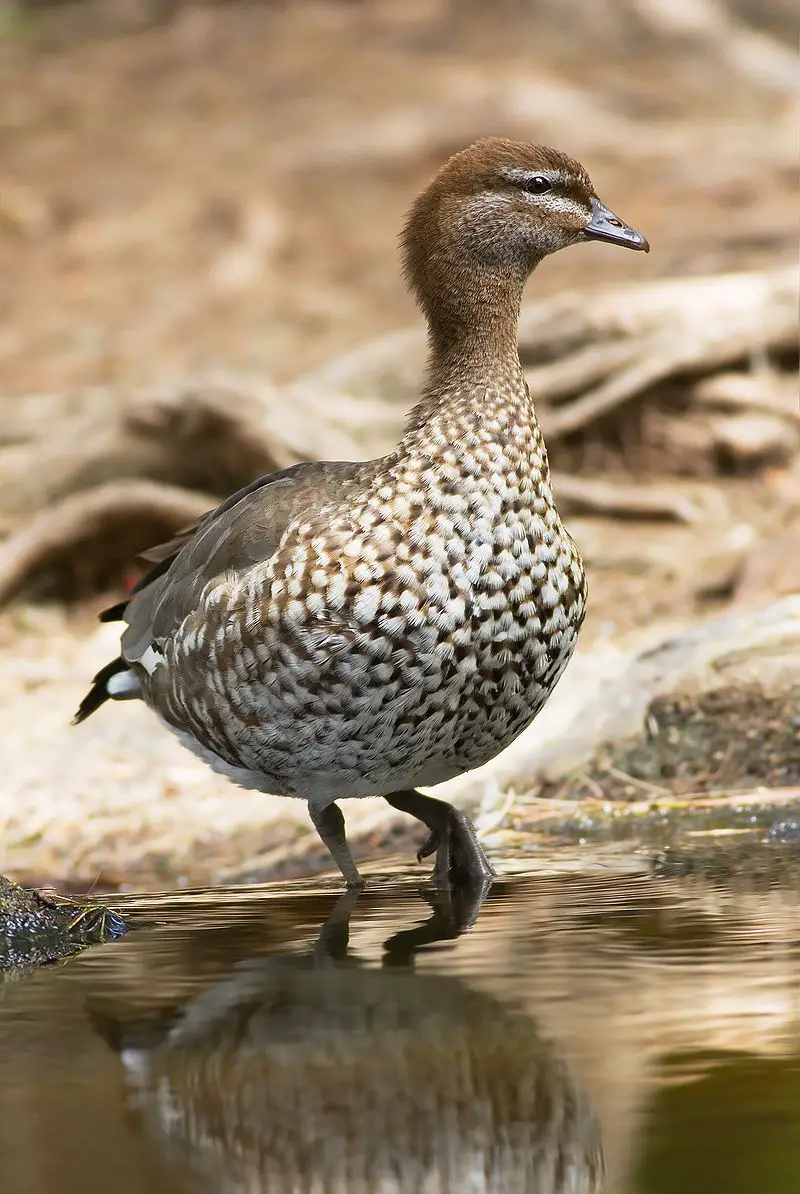
The Australian wood duck is a common waterbird species found throughout the country. It’s also known as the maned duck or maned goose due to its uniquely arranged feathers on the neck resembling a mane.
Interestingly, it’s the only species in the Chenonetta genus. Although typically considered a dabbling duck, recent studies suggest it may belong to the subfamily Tadorninae or shelducks. The species’ closest living relative is thought to be the ringed teal.
Australian wood ducks are medium-sized, with a distinctive plumage of gray, brown, and black, with males having brighter coloration than females.
They can be found near a variety of water sources, from wetlands to parks, and are known for their loud calls and social nature.Scientific classification:
| Kingdom | Animalia |
| Phylum | Chordata |
| Class | Aves |
| Order | Anseriformes |
| Family | Anatidae |
| Genus | Chenonetta |
| Species | C. jubata |
18. Australian Owlet-Nightjar
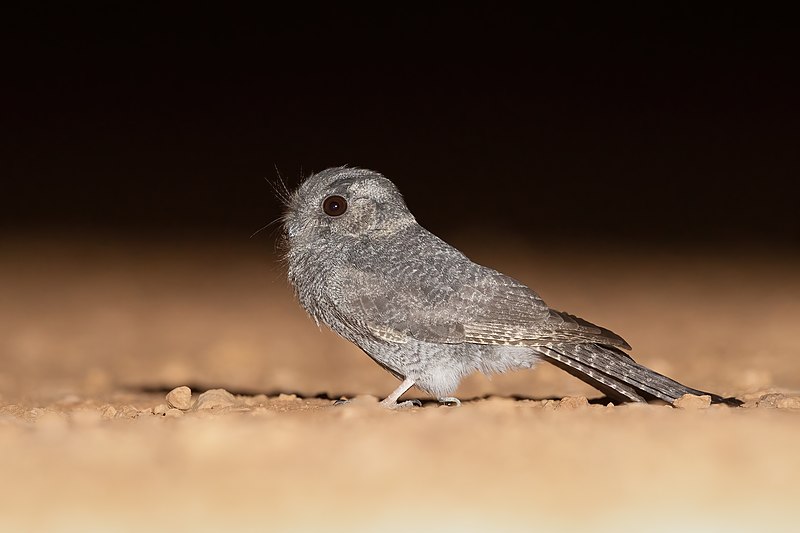
The Australian owlet-nightjar, also known as the moth owl, is a nocturnal bird found in open woodland in Australia and southern New Guinea.
Despite facing challenges from introduced species, it remains the most common nocturnal bird in Australia and is not currently considered threatened.
This small to medium-sized bird is known for its distinctive call and unique behavior, such as roosting in tree hollows during the day.
With its impressive adaptability and resilience, the Australian owlet-nightjar is a testament to the hardiness and tenacity of Australia’s diverse wildlife.Scientific classification:
| Kingdom | Animalia |
| Phylum | Chordata |
| Class | Aves |
| Clade | Strisores |
| Order | Aegotheliformes |
| Family | Aegothelidae |
| Genus | Aegotheles |
| Species | A. cristatus |
Also Featured In: Birds You’ll Find in Night, Common Townsville Birds